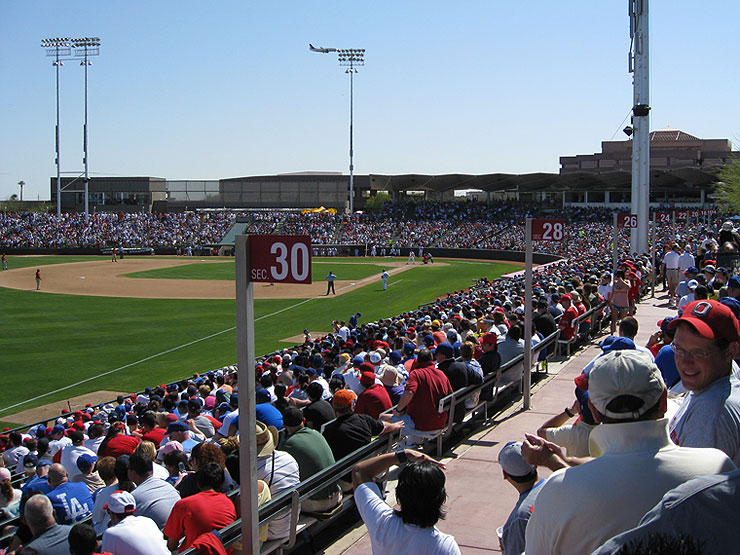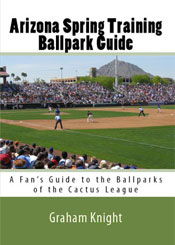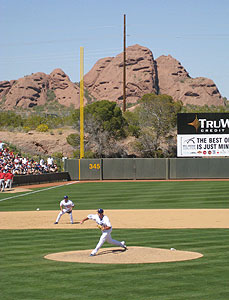
|
Phoenix Municipal Stadium is a throwback to the no-frills Cactus League stadiums of yesteryear. As such, itís a ballpark traditionalists will love and one that bears little resemblance to the areaís HOK inspired brethren.
Built in 1964, Phoenix Muni Ė as itís often referred to Ė doesnít wow fans with its utilitarian design. But what it lacks in style, it makes up for in location, as the ballpark is set against the backdrop of the stunning red rocks of Papago State Park. Phoenix Muni does a great job at blending in with its fantastic desert setting, starting with the weathered granite hand-laid marquee sign that greets passerbyís on the street that runs parallel to left field. The walls of the aisles that service the main grandstand are covered in rocks, as is the grandstandís exterior. Cactus is a common sight outside the ballpark, which most people access via a pedestrian bridge from the stadiumís parking lot. This walkway above Priest Street is ascended and descended from spiral ramps and takes fans to the main entry gate, located behind third base.
There is no berm seating. The area behind the outfield fence is off-limits and undeveloped, home only to numerous billboards. Because of the billboards, the outfield wall is virtually barren of advertising, a rarity these days. The main scoreboard in right center field provides basic information and a line score. Itís not capable of showing video. Elevated grassy picnic areas with concession stands can be found in both outfield corners. The one in left field serves portabella mushroom burgers, but the rest of the ballpark fare is standard stuff. Beer stands are plentiful and microbrews are featured. All concession stands located behind the concourse are far enough removed from it that they have no view of the playing field. There are no concession stands behind the main grandstand. The biggest treat of seeing a game at Phoenix Muni are the views of the red desert rocks in Papago Park, but only fans sitting in the right half of the ballpark can see them. Fans sitting on the left side are instead treated to the steady procession of airplanes that land at the nearby Phoenix airport. Quaint by modern spring training ballpark standards, Phoenix Municipal Stadium seats less than 10,000 and has only a few luxury suites. Renovations completed prior to the 2005 season spruced the place up, but as the Phoenix New Times wrote "a trip to the venerable 8,500-seater is about the game, not the place."
Location and ParkingThe stadium is on the easternmost edge of Phoenix and neighboring Tempe is so close that you can actually see its welcome sign outside of the ballpark on Priest Street. A large sign designating Phoenix Muni as the Home of the Oakland Athletics is located at the intersection of Priest and Van Buren, which is where the stadium resides. Commercial development around the ballpark is limited to some office buildings behind it, all of which are actually in Tempe. Papago State Park is the ballpark's famous neighbor with a Phoenix zip code, and is home to the Phoenix Zoo, Desert Botanical Gardens, and the Municipal Golf Course in addition to the famed red sandstone formations. Parking is $5 at the stadium's paved parking lot and, unless you want to walk a good ways, is pretty much your only option. As such, the Phoenix Muni lot is big enough to handle sell outs.

Phoenix Municipal Stadium Facts, Figures & Footnotes
| |||||||||||||||||||||||||



 The seating bowl runs from foul pole to foul pole and consists of seats between the dugouts and bleachers beyond. Seating section numbers are clearly displayed on red markers on the concourse. A concrete canopy roof provides limited shade; only those sitting in upper box seats will benefit. The upper box sections are also the only seats above the concourse.
The seating bowl runs from foul pole to foul pole and consists of seats between the dugouts and bleachers beyond. Seating section numbers are clearly displayed on red markers on the concourse. A concrete canopy roof provides limited shade; only those sitting in upper box seats will benefit. The upper box sections are also the only seats above the concourse.
